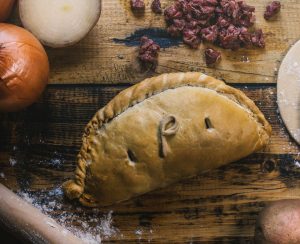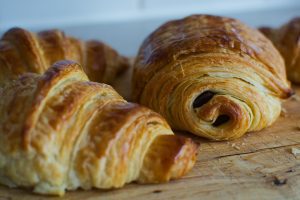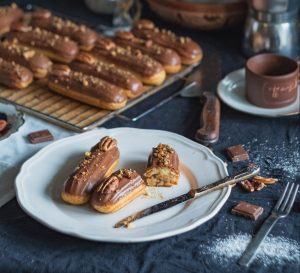Today the chief purpose of pastry is to complement the flavour of the fillings and to provide a casing. When learning about pastry it is important to know some terms. Paste is the uncooked pastry mixture with the fat added. It has less water and more fat than the dough which is used for bread and scones. In bakeries a special pastry margarine is used, whereas the tastiest fat to use at home is butter.
The two major types of pastry used in New Zealand are short and puff. Flaky pastry is a more quickly prepared version of puff pastry. Short pastry can be altered to make suet pastry and short sweet pastry. Other pastry types include strudel, filo and choux. Yeasted pastries such as Danish and croissants are made with yeast.
Puff Pastry
Puff pastry is a light, flaky and tender pastry. It is used to make pies, pasties, vol au vents, savouries and desserts.
Puff pastry is made by mixing flour, salt, a little fat and water to form a dough. The dough is then layered with fat, preferably butter, to form hundreds of layers of fat and dough by folding and rolling. When it is baked, water from the dough turns into steam and puffs up the pastry to produce lots of flaky layers. Flaky pastry is made in the same way but has less rolling and folding and is quicker to make.
Read more about Puff Pastry Ingredients & Making Puff Pastry
Short Pastry
Short pastry is a soft, tender pastry that is made from flour, fat, salt and water. It is made by mixing the fat and flour together, adding water and then rolling the paste. It is cooked at 180°C.

Different types of short pastry are used for different foods. Short pastry is used to make meat and other savoury pies. Short sweet pastry with added sugar, and sometimes eggs, is used to make fruit pies, Christmas mince pies and other sweet recipes for desserts. Suet pastry is used as a delicious cover on casseroles.
Yeasted Pastries
Yeasted pastries are a delicious product that originated in Europe, where they are traditionally eaten in the morning freshly baked and still warm. They are a cross between bread and puff pastry and so they should be crisp on the outside, like puff pastry, and soft and tender inside, like bread, and should melt in your mouth, leaving no aftertaste.

Two types of yeasted pastries are commonly eaten in New Zealand: Danish pastries and croissants. Danish pastries are found in all sorts of shapes, such as swirls and figures of eight. They are always sweet and can have a filling, such as custard, and icing on top, making a delicious snack or dessert.
Read more about Yeasted Pastries and how these are made
Choux Pastry

This is a French speciality used for cream buns, chocolate eclairs and profiteroles. The feather-light pastry surrounds a large cavity which is filled with cream.
The butter is boiled with a water/milk mix and then flour is added to it. This mixture is then beaten and eggs are added. The mixture is put in a forcing bag, and placed as rounds or lengths on a baking tray before being baked in a hot oven. When cool, the pastry is pierced to let out the steam, then cut open and filled with cream. These are delicious when filled with cream flavoured with essence – orange, coffee, caramel or chocolate. Chocolate icing is most often used to ice the eclairs.
Filo pastry

Leaved pastries are traditionally found in many parts of the world – Europe, the Mediterranean, the Middle East and China. All leaved pastries (apart from puff pastry) are made from a sheet of dough that is as thin as tissue paper – so thin you can read through it.
Traditionally, the dough is made by hand by gently rolling, stretching or pressing it into very thin sheets. Now we can buy it ready made.
In New Zealand it is sold as filo (or phyllo) pastry. Before baking, the dough is brushed with butter or oil. It is then used in different ways depending on the recipe. It can be cut into sheets and layered in a tin, cut to make individual rolls or rolled up as one large roll.
The pastry is filled with all sorts of delicious fillings – either sweet or savoury – for entrees, mains or desserts. These can include fruit, nuts and honey, meat or cheese and spinach. Popular recipes are traditional strudel from Austria, baklava from the Mediterranean, borek from the Middle East and spring rolls from China.
